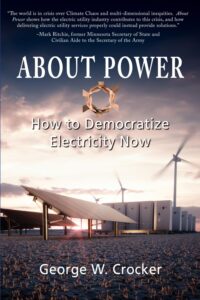
Version 1.0.0
BY LEE SAMELSON
A main driver of climate chaos is how energy utilities have incentives that are “upside down and backwards”, being financially rewarded by an outdated system when they effectively emit more pollution. If you are looking for an articulate exposé of the obsolete monopoly power structures that have slowed much-needed progress on climate justice, I recommend a new book titled “About Power: How to Democratize Electricity”. It is authored by George Crocker of the North American Water Office and Community Power. He compiles valuable stories from his over 4 decades of experience working for energy democracy causes and distills them into useful lessons, so that we don’t have to learn them from scratch. A particularly important one is how to best build out the renewable economy, in direct and practical terms.
We can meet Minnesota’s new 100 percent carbon free electricity energy goals quickly by taking an approach of strategically sizing and siting community-owned renewable energy projects so that they require little or no new transmission infrastructure. It would take 8-10 years to do the top-down transmission line development needed to build out renewable power in the model where relatively few corporations own massive wind and solar farms in remote locations. Since the UN climate chief says we have only effectively 2 years to finally make the clean energy transition, then why intentionally take the 8–10-year option? The reason is because building new renewable generation in a highly centralized manner makes it easier for these monopoly utilities to maintain their market share. Also, captive customers pay for new $2 Million-per-mile new High Voltage Transmission (HVT) lines and not them.
I have heard well-intentioned elected officials and other community leaders carry this assumption that we need to build numerous new HVT lines to make the renewable transition happen because that is what the loudest voices in the room echo. They all could greatly benefit from reading about the alternative way forward (with bonus benefits!) that George lays out in “About Power”. Dispersed and distributed renewable power would make our energy system more resilient to climate disasters, less reliant on natural gas backup, and would better enable the local ownership that will keep wealth circulating in our communities and creating jobs. Yet because of these outdated incentives, Xcel Energy has been in the news over imposing exorbitant fees to interconnect renewable projects that it does not own and for conspiring with the MN Public Utilities Commission (PUC) to slash the bill credits it pays to subscribers to some community-owned solar projects.
Most concerningly, neither Xcel nor CenterPoint have been willing to offer us the field-tested version of Inclusive financing, a regulatory reform that would allow customers to pay for energy efficiency improvements using the value of the energy they save. It would make it way easier for far more people to save energy by shaving the up-front cost and minimum credit score barriers. Saved energy in the built environment is the low hanging fruit for mitigating climate chaos – and should be noncontroversial. Yet I watched CenterPoint tell the PUC they would refuse to offer an Inclusive Financing pilot project unless they could get a guaranteed profit from it, which would come at the expense of customers reaping financial savings. Once again, the culprit is the outdated incentives of the old system – utilities being rewarded for selling a commodity (tying profits to sales) when they should be rewarded for providing a service.
This review is not simplistically about just selling a book though. It is about educating and organizing to build up political power. The sweeping systemic change we need in our electric utility landscape will only happen in time if a movement of energy democracy activists “understands with some precision, the energy future that we want and then organizes socially, economically and politically to get it” as Crocker writes on page 167.
As someone who was part of the Minneapolis Energy Options campaign of 2013, we observed quite a few who both get excited about having an opportunity to chart the course of our energy future, yet also express concern about not having enough knowledge about energy management to translate that into power. As a result, I helped launch a series of community education events called the Powerful Conversations Tour, where we give just enough info on the utilities’ perverse incentives to spark curiosity to learn more about the topic, and to inoculate us from getting bamboozled by misleading propaganda from conventional utility business management.
Similarly, we can expect George Crocker to do some book telling events and radio interviews like his Oct. 10 radio interview with Don Olsen’s Northern Sun New show on KFAI.
Energy is fundamental to society. When we successfully chart the course of our energy future, then we’ll have the energy to get the rest of it right.






















